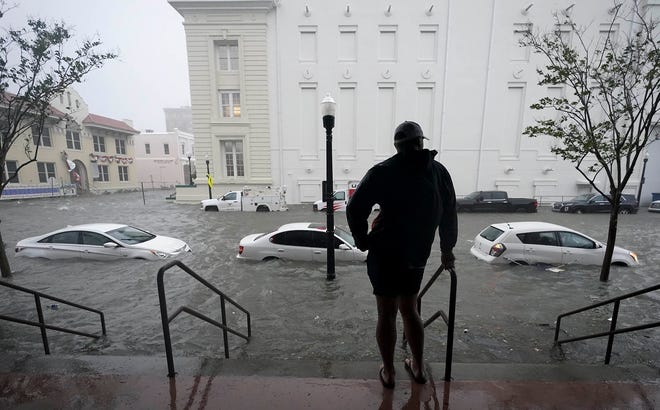Hurricane Sally's storm surge in Pensacola was historic, but we still don't know how bad it got

Hurricane Sally stole the roof from the Paradise Inn with a single graceful swoop, and flooded its buildings with a foot-deep black swell from Santa Rosa Sound.
Fred Simmons, who owns the Paradise Bar and Grill and Paradise Inn on Pensacola Beach, has a rain-fogged video of the arcing departure of the roof from his two-story hotel and photos of the debris left from a saltwater overflow he estimates rose as high as nine feet.

“It’s amazing when the water comes up on the sound side,” said Simmons, who reopened the bar and grill Tuesday. “We just didn’t think Sally was going to be anything big, nobody did.”
More:Hurricane Sally's stall was calamitous for Gulf Coast; will slow-moving storms be a trend?
The official National Weather Service estimate for storm surge at a gauge on the mainland side of Pensacola Bay is 5.6 feet, but that’s the tricky thing with surge, high-water marks may tell a different story.
With a rapid-fire onslaught of hurricanes this season, the National Hurricane Center hasn’t been able to send a team to do a formal Hurricane Sally surge investigation, and there may not be anything official released until the Sally post-mortem is completed later this year or early 2021.
Hal Needham, lead scientist for the Alabama-based Catastrophe and National Claims, or CNC, has been building a database of storm surge events for several years as part of a project called U-Surge.
U-Surge includes water height measurements that calculate for sea-level rise and tide.
Needham’s measurement for what he calls a “storm tide” for Hurricane Sally is 6 feet. With sea-level rise, he said total saltwater inundation was 6.53 feet. The historic rate of sea-level rise for Pensacola (1923-2015) is 0.81 feet, or 9.72 inches, per century, Needham said.
More:A Florida island has turned into multiple islands after Hurricane Sally slices through
“What people really care about is the maximum water level, how much higher the saltwater was compared to where it would have been without a storm,” Needham said. “People don’t care if it was 80 percent storm surge and 20 percent tides.”

Storm surge is the abnormal rise in seawater level measured above the normal predicted astronomical tide.
The National Weather Service notes that Sally’s storm surge at the Pensacola gauge was the third-highest in recorded history behind Hurricane Ivan’s 9.54 feet in 2004 and the 1926 Miami Hurricane’s 7.42 feet. The 1926 hurricane made landfall near Miami as a Category 4 storm, traversed the state into the Gulf of Mexico, and then reached Pensacola as a Cat 3.

Needham dug back into historical records before the Pensacola gauge was set up in 1923 and found another storm ahead of Sally.
He said an unnamed 1906 hurricane that made landfall west of Mobile Bay as a Category 2 cyclone sent 9.97 feet of storm tide into Pensacola.
That would put Sally in the fourth spot for highest storm tide on Needham’s scale, with Hurricane Katrina coming in fifth.

“It seems counterintuitive because people put their boats in bays because 99 percent of the time that’s the safest place,” Needham said. “But in a storm surge event, water funnels in there and gets trapped so it’s common to see the highest storm surge in the bay.”
Simmons said sand dunes on the Gulf of Mexico side of Pensacola Beach largely protected his home.
“The water came up and it was splashing over, but it never broke the dunes,” he said.
To complicate storm surge measurements, waves can ride on top of the surge causing even higher water levels, said National Hurricane Center storm surge specialist Jamie Rhome.

Rhome cautions against ranking storm surge events because of the deficiencies in looking at a single gauge.
“All we know is the surge was at least 5.6 feet,” he said. “It remains to be seen if it’s much more or how much more. That requires looking at the high water marks, we don’t have yet.”
The National Hurricane Center had extended a storm surge warning to the Okaloosa/Walton County line in Florida at 5 p.m. EDT on Monday Sept. 15 – 37 hours before Sally made landfall near Gulf Shores, Ala. as a Category 2 hurricane with 105 mph winds.
Forecasts for storm surge along the coast and in Pensacola Bay steadily increased from 2-4 feet early Sept. 15 to 4 to 7 feet in the hours before landfall.
More:Perdido Key man's drone footage show Hurricane Sally's devastation in Pensacola
“This is a reminder that even small amounts of storm surge in the right spot can be very destructive,” Rhome said.
For Simmons — who said his hotel and bar are one of the few remaining “Old Florida” establishments in Pensacola Beach — he’s hoping he can repair his structures rather than rebuild them. A total rebuild would likely mean pricey additions to meet storm codes.
“I’m trying to keep something here for the poor man,” said Simmons, who also had damage after Hurricane Ivan. “I swear, I keep saying I won’t do it again, but I keep doing it. This is the price you pay for living in paradise.”
Kmiller@pbpost.com
@Kmillerweather